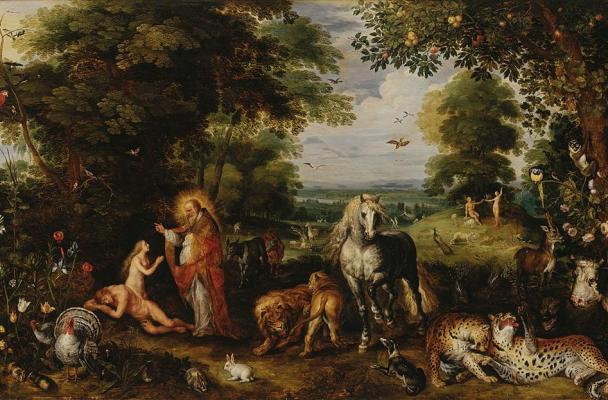For The Sake of Mercy and Love

Ophelia Luu
Written for COLL-C103: Word Hard, Pray Hard
Instructor: Prof. Sonia Velazquez
In Jan Brueghel the Elder’s painting of “Garden of Eden with Creation of Eve,” there are several animals depicted within this piece of art. Horses, lions, and tigers surround the central figure: God. At first glance, I felt a sense of busyness within the painting. As I continued to examine the image, I noticed that there were quite a few animals inserted in the painting and due to this there was lack of blank space. As well, the collaboration of dark shades fulfills the purpose for the canvas. Nonetheless from feeling busyness, I also felt joy looking at the painting because it showed the concept of creation and the purity found within creation. This thought brings me to God’s creation of Adam and Eve. There are two showings of the couple, one in the front and one in the back near the horizon of the valley. The significance of the two accounts of Adam and Eve are that each scene depicts a before and after reaction of their sinful behavior (eating the forbidden fruit). One of the sightings is located in the back of the painting where it seems like Adam and Eve are enjoying their time; this must be just before they fell into temptation. Surrounding them is a bright light they share while dancing, but this changes once the viewers reach the front account of the pair, they see that impurity has entered humanity through the facial expressions and the colors used within the artwork. Despite that, it is crucial to point out that God is still present in the picture, no matter the amount of shame He experiences due to Adam and Eve’s betrayal. This reveals God’s compassion for His creation and His willingness to take care of it and His expectation for us to do the same.
As mentioned earlier, one account of the two is near the front of the painting. Adam and Eve are enlarged in this painting compared to the one in the background, and the scene particularly portrayed here is God’s creation of Eve. The viewers see Adam on the ground asleep, which is what God did in order to take one of his ribs to make Eve. It’s a biblical story that is widely known, plus the title of the painting makes it clear that this is what God’s intentions were. There is something quite interesting about Eve’s position. She is on her knees looking up to God with her hands clasped together. Could this be an act of praise or an act of pleading? The act of praise seems to be the most reasonable because anyone would praise God when He created them if they got the chance. One question that comes to mind is what if it’s an actual foreshadow of Eve asking for God’s forgiveness after she has eaten the fruit? Even the animals that surround her, such as the leopard, his face of agony and the sharp grimace on the lion’s face, reveals that something awful has occurred. The dark shades of browns, greens, and blues present a disheartening aura. Looking at Eve in this painting uncovers the human nature of sinning and then asking for forgiveness. This process repeats itself over and over again until the end of time.
This correlates nicely with the topic of entropy that is discussed in Saint Francis’s Encyclical Letter, where he tackles the subject of destruction of nature and humans being the direct source. A few examples he provides are global warming and pollution. Out of the desire to satisfy selfish requests, humans are seen to be harmful to the environment – the ‘perfect’ environment that God made for Adam and Eve to live in as shown in Brueghel’s painting, with dark green trees, blue, cloudless skies, and bright colored animals. Humans forget the reason God created them, and more importantly, what He created them from. Saint Francis states: “we have forgotten that we ourselves are dust of the earth (cf. Gen 2:7). Soon enough, humanity runs back to God pleading for His mercy because the only thing “dust” can do is make a mess of its surroundings.
In the second account of Adam and Eve, there is a serpent intertwined within the branches of the tree that Adam and Eve are dancing by. This begins to signify that sin is awfully close, but God’s love shines “like a city on a hill” (Matthew 5:14) and draws out the darkness. To portray this, there is a large portrayal of lighting in the painting. Looking at the front scene of Adam and Eve, the use of light around Eve is extremely dark. This portrays the evil within humanity and the habits of failing God time after time. Though, hope shall not be lost because as shown in the painting, the light around God is quite radiant. God is light; He is what brings goodness amidst in a world of darkness. As he stands right next to Eve he the viewers can see His abundant love, even when she has sinned.
Creation sprouts from the idea of wanting to take care of something out of an unmeasurable love. As part of a summarization of Genesis chapter one, God creates humans to watch over the animals and plants, and God watches over the humans. Though, the depressing truth is that humans fall short, because humans don’t have the same love for nature, this is shown with the severe pollution that is conquering the earth.

Leave a comment